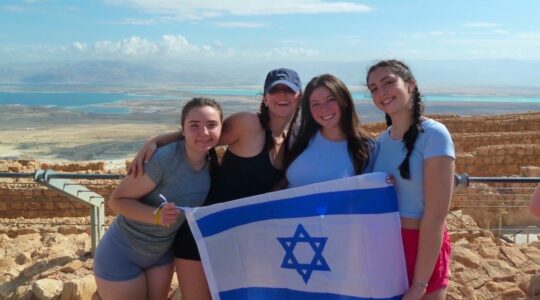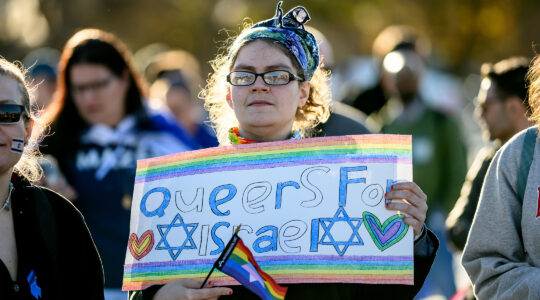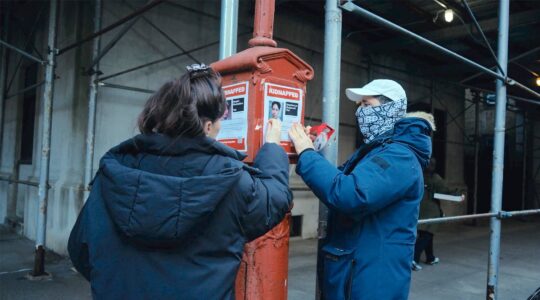JERUSALEM (JTA) — Amid the alleyways that zigzag through Jerusalem’s Nahlaot neighborhood, a nonprofit collective run by five young artists is trying to make art more accessible in a city known more for conflict than culture.
The turquoise gate of Barbur Gallery opens onto a stone courtyard and garden where secular and religious locals — and the occasional tourist from Tel Aviv — drop in for a look at the latest exhibit: a collection of black-ink drawings mixed with splashes of bold color. The gallery also is a regular gathering spot for lectures, movie screenings and musical performances.
Barbur is one of a growing number of independent art spaces here that along with booming music venues, a growing list of festivals and the newly redesigned Israel Museum is breathing fresh cultural energy — and even a hipster edge — into Jerusalem.
“Jerusalem’s cultural scene was not exactly neglected, but it was not taken care of so well in the last decade,” said Peppe Alalu, the City Council member in charge of culture. But recently, Alalu said, the city has set a goal to “make Jerusalem a center for culture, so people will have where to go out and enjoy themselves.”
Roy Brand, director of a new gallery downtown known as Yaffo 23, its street address, agrees.
“I think we are now coming out of this into a better situation,” said Brand, who is on sabbatical from his position as a philosophy professor at Sarah Lawrence College in New York to launch and develop the gallery in Jerusalem.
Yaffo 23 exhibits and researches contemporary art and hosts continuing education classes.
Brand hopes the physical location of the 10,000-square-foot space — across from City Hall and down the road from the Old City on the third floor of a British Mandate-era building that houses the city’s main post office — will expose more locals to the art it is exhibiting and serve as a reminder of Jerusalem’s artistic bounty.
“This is perhaps the most diverse part of the city, with Arabs, haredim, secular, Russians, tourists, Ethiopians and Armenians all coming through,” he said. “And this is a place where the desert and the city meet, where different cultures historically met, and till today it is still like that.”
In interviews, artists in Jerusalem noted that although there is an active arts scene nearby in traditionally Arab eastern Jerusalem, there is little official contact between Jewish artists and their Palestinian counterparts, who have boycotted cultural contacts with Israeli institutions.
“It’s understandable, but also sad,” said Lee He Shulov, a painter. “It’s a reflection of the political reality in Israel.”
The city’s tensions can fuel good, thoughtful art in response, said Yael Robin, an installation artist.
“It’s very complex here,” she said. “It’s full of contradictions and complexities and difference between societies and peoples but in the extremity of what goes on here is also produced good music, theater and art pieces.”
Yaffo 23’s goal is to help unpack some of that complexity.
Opened last fall, it is run by the Bezalal Academy of Arts and Design, Israel’s premier art school. For the past two decades, the school has been located on a hill overlooking the city on Mount Scopus, but it has plans to build a new campus in downtown Jerusalem. The move is expected to infuse a major jolt of culture into the city.
“What will save the city is having Bezalel back downtown again,” said Alon Itzkin, a 27-year-old architecture student. “Already you see it with the architecture department, which has already been moved to the center of the city. Surrounding it the streets brim with students, and five new cafes have been opened nearby that are already packed.”
On Fridays, on a pedestrian stretch of Bezalel Street, the same road where the school’s architecture program is located, a lively and popular arts fair has taken root that is also credited for helping revitalize the urban pulse of Jerusalem.
Here on a street lined with cafes and boutiques, local artists sell their wares including high-end ceramics, photography, woodworking and clothes.
Another recent addition to Jerusalem’s arts scene is a festival that was launched officially this summer called the Jerusalem Season of Culture, which aims to highlight the city’s cultural offerings both by local artists and visiting international ones.
The festival — initiated by the Schusterman Foundation-Israel and funded together with several other family foundations, the Jerusalem municipality and the Jerusalem Foundation — commissioned a musical montage in homage to Jerusalem by Kutiman, an Israeli artist and YouTube sensation.
One of its most popular events takes place on Monday nights in Machane Yehuda, the city’s open-air fruit and vegetable market, in an event called Balabusta, a mix of street theater, backgammon tournaments and musical interludes in a carnival-like atmosphere among the vendors’ stalls.
In recent years, the souk has featured pockets of gentrification, with cafes and gourmet ice cream shops across from stalls selling dried goods and a tiny French bistro. Nearby is a restaurant called Machneyuda that’s so popular that reservations are taken three weeks in advance.
Last week, a late-night program at the Israel Museum called “Contact Point” brought top Israeli musicians, dancers and writers to interpret and interact with specific pieces of art and exhibits for an audience of late-night museum goers.
The idea was that by watching the artists’ interactions with the museum displays, which underwent a $100 million redesign and expansion last year, visitors get an alternative, user-friendly way of consuming and understanding art.
“It’s part of the rich assertion of Jerusalem’s culture,” James Snyder, the museum’s director and the former deputy director of New York’s Museum of Modern Art, told JTA as he stood amid the crowds following a dance performance held beneath the towering figure of an African refugee boy to Israel.
Jerusalem’s cultural decline has been blamed in recent years on its changing population. The Jewish secular middle class is departing in search of better jobs and more affordable housing, leaving the city to the surging haredi Orthodox population, the Arabs and the wealthy but absentee Diaspora Jews who own apartments here but leave them vacant most of the year.
City officials say a shrinking tax base has made it difficult to fund cultural projects more generously.
Shulov, the painter, says city government isn’t doing enough to promote artistic culture.
“The city talks about how important culture is in Jerusalem, but it does not invest in its artists by finding solutions for us who have problems trying to find work and have studios,” she said.
Shulov is one of the organizers of an arts festival now in its third year called Manofim, which was initiated by a group of Jerusalem artists and galleries in an effort to map out the city’s art scene. The festival is scattered throughout various neighborhoods, making it more accessible for Israelis and tourists.
Some other Jerusalem hot spots:
Jerusalem Artists’ House, a public gallery, is housed in the original Bezalel Art Academy and is open daily.
Tower of David, a museum of the history of Jerusalem, is housed in what was once a crusader fortress. It also features a high-tech light show several times a week that retells the city’s history and a recently renovated performing arts space in the Kishle, the site of a former Ottoman prison.
Museum on the Seam deals with socio-political contemporary art to explore the regional conflict in a different way.
Lev Smadar is a small independent movie theater much beloved by locals in the Emek Rafaim neighborhood.
Cinemetheque is an art movie house and home to the annual Jerusalem International Film Festival. Recently renovated, it overlooks the Old City walls.
Yellow Submarine is a favorite music venue in the city.
JTA has documented Jewish history in real-time for over a century. Keep our journalism strong by joining us in supporting independent, award-winning reporting.





